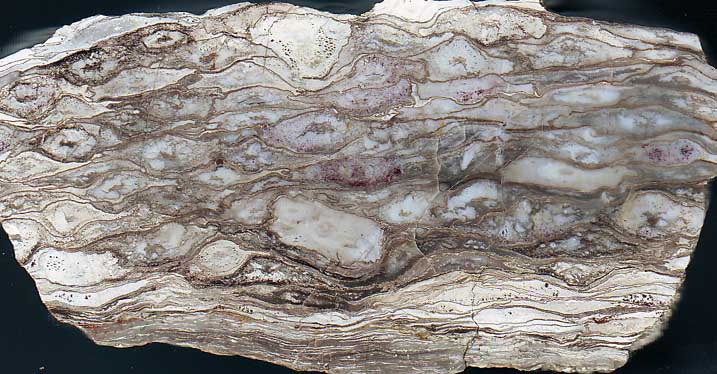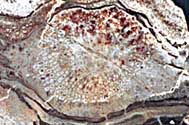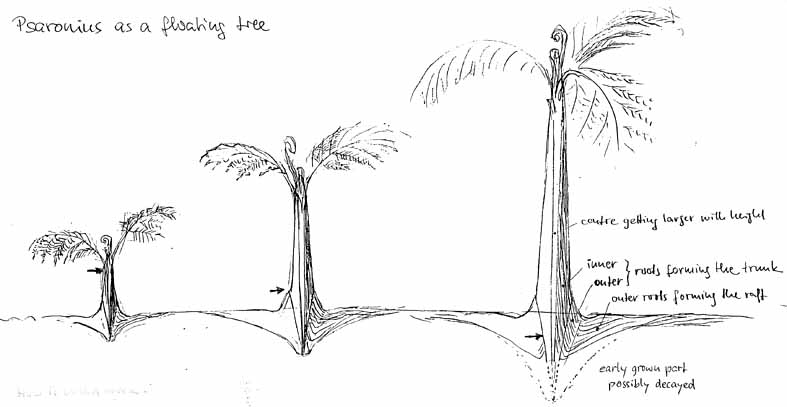Psaronius /Scolecopteris – a
floating tree fern ?
An idea suggested by fossil evidence
Stems and fronds of Palaeozoic tree ferns of the family Psaroniaceae
[1] have got separate names for practical reasons: Usually they are
not found together so that it is virtually impossible to establish a
species covering both foliage and stem. Or else there can be several
species present in the same petrified biotope, which likewise makes it
difficult to find out which foliage belongs to which stem. The stems
are called Psaronius,
the foliage is called Pecopteris
if preserved as a compression fossil, otherwise it is subdivided into
several genera including Scolecopteris.
Nowadays
the name Psaronius
is also used for the whole plant but the other names are still
valid. The genus Scolecopteris
has been subdivided by Millay
[1] into 26 species.
A drawing
by J. Morgan [2] thought
to be more or less representative for some or all
Psaronius
/Scolecopteris
species has been published
repeatedly in monographs [3,4]. These drawings, however, begin always
above ground level although there are reasons to assume that a good
deal of the tree is hidden below.
Any attempt to reconstruct the lowest part of Psaronius has to
start
from the peculiar structure of the tree trunk: Most of it consists of
apparently strong aerial
roots running down the stem, connected by soft
tissue. The stem proper, without the roots, is widest at the top where
it bears the fronds but very narrow near the ground. It is as narrow
there as it had been in the juvenile stage because there is no
subsequent lateral growth. There is no primary root left, hence the
whole tree rests on its aerial roots.
Far-reaching conclusions can be drawn from one feature of the aerial
roots: As they get near the ground while growing downward, they develop
air-filled tissue, the aerenchyma, thereby largely increasing their
cross-section. They become more and more detached from each other,
hence their lower parts are called free aerial roots.
The free aerial roots are seen beautifully preserved on cross-sections
of
the
lower part of the large Psaronius
tree trunks displayed in museums [5] but
usually they are not found fossilized in the
ground.
This may be due to the event which supposedly led to the fossilisation
of the conspicuous trunks: a volcanic eruption causing a
pyroclastic flow moving down the slopes at high speed (typically about
400km/h) and spreading over level ground, thereby tearing the trees
from their
base and possibly blowing away their habitat as well, scattering the
roots
together with the soft ground or mud. So it can be understood that the big Psaronius specimens displayed at the Naturkunde Museum Chemnitz had not been found silicified together with the related parts of the tree.
Luckily, the fossilisation of tree ferns was not always
preceded by
catastrophic events so that occasionally all parts of the tree, namely
the free aerial roots in the ground, the stems with the fused aerial
roots, and the foliage, are found in the swamp matter turned into chert.
Numerous chert samples representing a wet habitat with layers of peat
and mud silicified while at or near the surface have been found lately
in the Lower Permian Döhlen basin. Moults of the aquatic crustacean
Uronectes
and extended microbial layers found among the remains of Psaronius /
Scolecopteris indicate
that
there was not only wet ground but free water as well. Part of the chert
samples contain aerial roots (Figs.1,2), some of which are preserved in
a non-collapsed state.

Fig.1: Psaronius "free"
aerial roots
in the ground, more or less squeezed before silicification, aerenchyma
(air-filled tissue) poorly visible here, layered peat consisting
of collapsed roots below. Döhlen basin (Lower Permian), type locality of
Scolecopteris. Width of the picture 9cm.

Fig.2 (right): Psaronius
free aerial root cross-section with aerenchyma,
originally air-filled tunnels up to 0.5mm across.
Width 1.5cm.
Site: Type locality of the "Maggot fern" Scolecopteris elegans at the boundary between Kleinnaundorf and Burgk, Döhlen basin, Saxony, Germany.
Samples:
Fig.1: Bu13/31.3 ; Fig.2: Bu13/35.2 ; found in 1998 on the property
Kohlenstr. 8. The recovery of these and numerous other samples has
been furthered by the interest of the owners, family Beyreuther.
The idea suggests itself that the mass of tangled and branching
air-filled free aerial roots would have enough buoyancy in soft mineral
mud or even in water or organic mud to support the whole tree. This
would be doubtless an advantage or even a precondition for
the growth of trees on
wobbly ground. Since Nature usually realizes favourable options, it is
worth while considering the implications of such design. One
implication is evident from Fig.3.

Fig.3: Advantage of a floating tree in strong winds: Does not get
rooted up or broken off.
If
there were floating trees among the several Psaronius species,
what
could be predicted about their successive growth ? The answer is
visualized in Fig.4.
The tree sinks in as it grows, with buoyancy
increasing such that it keeps equilibrium with the increasing weight.
This may explain why the lowermost part of the stem with its tiny
centre dating back to the earliest growth stadium is never seen on the
conspicuous polished stem cross-sections displayed in museums [5]: This
oldest part of the plant had most probably been dead and gone before
the tree became big.

Fig.4: Hypothetical design of floating Psaronius:
Equilibrium
of the growing tree is maintained by successively sinking in, as
indicated by the arrow supposed to be fixed to the trunk.
Stability against upsetting is brought about by the large raft of
air-filled roots.
H.-J.
Weiss
2011
[1] M.A. Millay:
A review of permineralized Euramerican Carboniferous tree
ferns. Rev. Palaeobot. Palyn. 95(1997), 191-209.
[2] J.
Morgan: The morphology and anatomy of American
species of the genus Psaronius. Illinois Biol. Monogr. 27(1959), p1-108.
[3] W.N. Stewart,
G.W. Rothwell: Paleobotany and the
Evolution of Plants. Cambridge Univ. Press 1993, p228.
[4] T.N.
Taylor, E.L. Taylor, M. Krings: Paleobotany,
Elsevier 2009, p418.
[5] R.
Rössler: Der versteinerte Wald von Chemnitz. Museum für
Naturkunde Chemnitz, 2001.
|
 |
 7 7 |

 7
7




 7
7